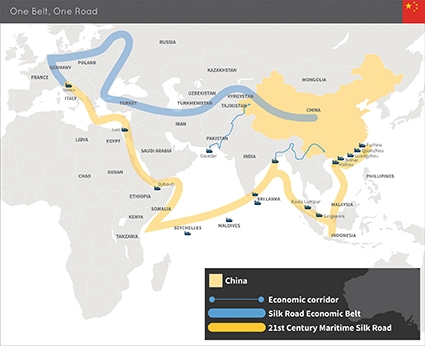Georgia & Silk Roads: Belt & Road Initiative
The ancient Silk Road, or as it is more often called nowadays silk roads, was an ancient trade route from eastern China to various major markets of the ancient and medieval periods (Roman/Byzantine empires, Sasanian Iran, the Arab Caliphate, etc). An important aspect to those trade routes was their changeability over time. This depended mostly on the political situation in the Middle East and this necessitated the seeking out of alternative routes to get important products from Central Asia and western China.
Contrary to widespread arguments, Georgia appeared on those trade routes only from time to time as a result of political disturbances (invasions, economic problems, etc.) in the region. The trade route across Georgia passed from North to South, from Georgia itself further south to Armenia and Iran as well as from East to West. Thus it is difficult to say that Georgia was either totally absent or dominated ancient and medieval trade routes. The Russians at times opened the Georgian transit route for European products to reach Iran in the 19th century. But the success of this commercial road ultimately depended on Russian political decisions. As is also well known that in Soviet times, virtually no international trade routes ran through Georgia as the Union was a closed-border one.
Thus, for the first time in many centuries, Georgia now has the chance to become a transit corridor for trade and energy from the Caspian area, Central Asia and even from western China. Refocusing on Georgia’s transit potential is linked to China’s economic and military rise which is arguably one of the central themes in 21st century geopolitics. Like many other rising powers throughout history, China has strategic imperatives that clash with those of the US. Beijing needs to secure its procurement of oil and gas resources, which are currently most available through the Malacca Strait. In an age of US naval dominance, the Chinese imperative is to redirect its economy’s dependence, as well as its supply routes, elsewhere.
This is how it comes to the almost trillion-dollar Belt and Road Initiative (BRI), which is intended to reconnect the Asia-Pacific with Europe through Russia, the Middle East, and Central Asia. There are several major corridors pinpointed by the Chinese:
1. China to Europe through the New Eurasian Land Bridge;
2. The China-Mongolia-Russian Corridor;
3. Central and West Asian countries.
4. The China-Indochina Peninsula Corridor linking China with the South Pacific Ocean through the South China Sea;
5. The China-Pakistan trade corridor;
6. The Bangladesh-China-India-Myanmar trade route.
As seen, neither Georgia nor the South Caucasus feature on the list and many analysts think that this is proof that China will unlikely be interested in the South Caucasian route. Yet, the nature of the BRI is not static; it undergoes constant changes and it is likely that Beijing will always adjust its trade routes to rising challenges and new opportunities, trying to operate through difficult geographic terrain as well as politically unstable regions. These are Beijing’s major enemies which make any routes vulnerable and susceptible to re-routing. And this is very much similar to how transcontinental trade routes operated in ancient and medieval periods.
Thus China has and is likely to have in future, an individual approach to each country, which makes the fact that Georgia does not feature on the above-mentioned list of trade routes not an obstacle per se. China is responding to rising opportunities and in that sense Georgia’s ability to develop its Black Sea ports, internal railway and highway networks will facilitate China’s decisions on the active inclusion of the South Caucasian route in its BRI or any future commercial undertakings.
Surely the Chinese also look at the security of the South Caucasus and it is difficult to imagine that Beijing will not take into account Russian moves in the region. Mitigating the Russian challenge together with opening the Georgian market to other powerful players in Eurasia is arguably a modus vivendi for the region’s successful development.
By Emil Avdaliani
Image source: Dmitrii Vaccinium/Unsplash











